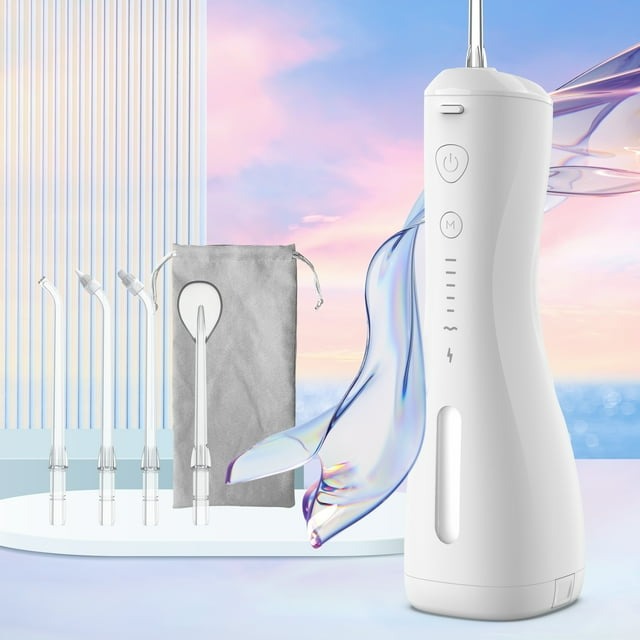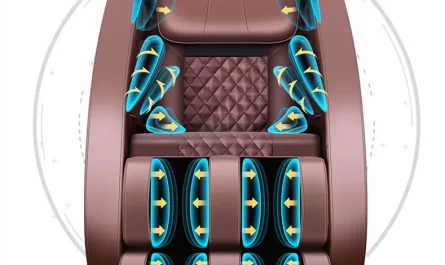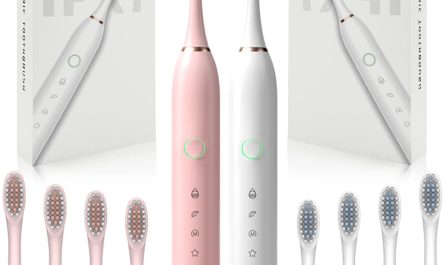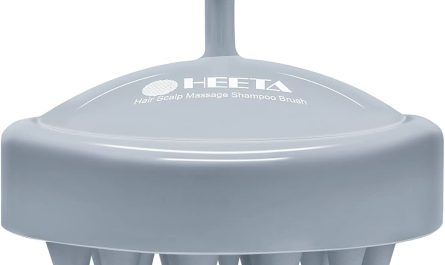The Importance of Dental Hygiene
Good dental hygiene is vital for a healthy mouth and body. It helps prevent cavities, gum disease, and tooth loss. It can also reduce the risk of secondary problems caused by poor oral health, such as heart disease or diabetes. A core component of dental care is regular flossing. Flossing removes food particles and plaque from between teeth, where a toothbrush can’t reach.
Using a handheld water flosser is a modern and effective way to enhance dental hygiene. Handheld water flossers use a stream of pulsating water to clean between teeth and below the gumline. They are an alternative to traditional string floss. Many people find them easier to use, especially those with braces or other dental work.
Flossing with a handheld water flosser can be gentle on the gums and make daily cleaning enjoyable. It is a step to a brighter smile and healthier life. Tooth decay and gum disease can set in fast without proper care. Daily use of a handheld water flosser can be a game-changer for oral health.
In conclusion, maintaining dental hygiene is a key part of overall health. A handheld water flosser can be an important tool in achieving this. Coupling it with regular brushing and professional dental check-ups ensures the best defense against oral diseases. So grab that handheld water flosser and take a firm step towards optimal dental hygiene.
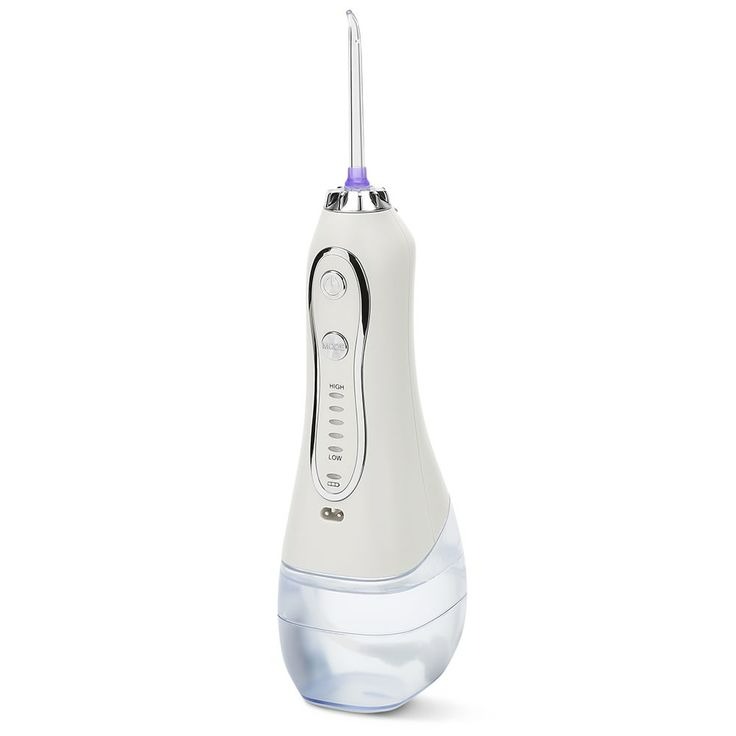
What is a Handheld Water Flosser?
A handheld water flosser is a dental cleaning device. It uses a stream of water to remove food particles and plaque. This stream is pulsating, reaching deep between teeth and under the gumline. It’s different from string floss. Unlike string, the flosser doesn’t require manual scraping action. People find it easy to handle. This makes it ideal for those with braces, bridges, or crowns.
Handheld water flossers are portable and convenient. They typically come with a motor, water reservoir, and a special tip. You fill the reservoir, point the tip at your teeth, and turn it on. The water does the cleaning for you. Some models are even waterproof. This means you can use them in the shower.
These flossers are effective for cleaning hard-to-reach areas. They also massage the gums, which can improve gum health. With regular use, a handheld water flosser can contribute to a rigorous oral hygiene routine. It’s a tool that supports dental wellness for people of all ages.
Key Benefits of Using a Handheld Water Flosser
A handheld water flosser offers several advantages for maintaining oral health. Here are key benefits:
- Ease of Use: Handheld water flossers are user-friendly. They are simple to operate, making flossing less of a chore.
- Effectiveness: The pulsing stream reaches spots that traditional floss can miss. This can lead to better plaque removal and prevention of gum disease.
- Gentle on Gums: Unlike string floss, water flossers are gentle. They reduce the risk of bleeding and gum irritation.
- Convenience: Its portability allows you to maintain dental hygiene at home or on the go.
- Ideal for Braces: For those with braces, handheld water flossers are particularly beneficial. They clean around wires and brackets easily.
- Improves Gum Health: The massaging effect of the water can boost gum circulation. This promotes healthier gums.
- Adjustability: Many handheld water flossers come with adjustable settings. They allow you to customize the pressure to your comfort level.
- Reduces Bad Breath: By thoroughly cleaning your teeth and gums, a handheld water flosser can help keep your breath fresh.
In short, for effective daily dental care, adding a handheld water flosser to your routine can be a wise choice. Its multiple benefits support a clean, healthy mouth and can enhance your overall dental hygiene.

How Handheld Water Flossers Work
Understanding how handheld water flossers work is key for effective use. These devices rely on a few main components that contribute to their cleaning ability. Here’s a simple breakdown:
- Motor and Pump: Inside the flosser, a motor operates a small pump that generates the pressure needed.
- Water Reservoir: Before use, fill this with warm water. Some models accommodate mouthwash for extra freshness.
- Nozzle or Tip: This part directs the water stream. Point it at the spaces between your teeth.
- Control Panel: Use this to adjust water pressure. Start low to avoid gum discomfort and increase as needed.
When you turn on the flosser, the motor activates. It pushes water from the reservoir through the pump. Then, water pulses out of the nozzle in a strong, steady stream. Aim the tip at the gumline and between teeth. Move it along, pausing briefly between teeth. The water dislodges food and plaque efficiently. This process is gentle, reducing potential for gum irritation that string floss may cause.
A handheld water flosser cleans thoroughly with less effort than traditional floss. It’s a reliable tool for optimal dental hygiene. Regular use can help prevent dental health issues. Make sure to floss at least once a day for best results. A handheld water flosser makes this easy and effective.
Comparing Water Flossing to Traditional Flossing
In considering dental care, it’s crucial to understand the differences between water flossing and traditional flossing. Both methods aim to clean between teeth and under the gumline, but they have distinct features and benefits.
- Technique: Traditional floss involves a piece of string that you must thread between each tooth. This takes skill and care. Conversely, a handheld water flosser uses a jet of water. It cleans teeth with minimal effort.
- Comfort: Water flossing tends to be gentler on the gums. Traditional floss can sometimes cause minor bleeding or discomfort. A handheld water flosser offers a comfortable alternative.
- Efficacy: For people with braces or permanent fixtures, water flossing is more effective. It reaches areas where string floss can struggle.
Choosing between these two methods might come down to personal preference or specific dental needs. Water flossing stands as a modern, comfortable, and effective choice. It simplifies the flossing process for many individuals. Remember, the best flossing method is the one that you will consistently use as part of your oral hygiene routine.

Selecting the Right Handheld Water Flosser
Choosing the right handheld water flosser is important for your oral health regimen. Look for a model that suits your specific needs and preferences. Here are factors to consider:
- Adjustability: Check for multiple pressure settings. This lets you find a comfortable intensity for your gums.
- Battery Life: If you’re often on the move, long-lasting batteries are key. Find a flosser that holds a charge well.
- Tank Capacity: A larger reservoir means fewer refills. It’s convenient for a thorough clean.
- Design: Choose a flosser with an ergonomic grip. It should feel comfortable in your hand.
- Tips and Accessories: More tip styles can mean better cleaning for different dental work. Look for units with multiple tips.
- Ease of Cleaning: Ensure the water flosser is easy to clean. Models with detachable tanks are often simpler to maintain.
- Noise Level: Some flossers are quieter than others. If noise is a concern, test this before buying.
With the right handheld water flosser, you can maintain exceptional dental hygiene easily. Take the time to compare different models and features. Always weigh them against your personal needs. A good flosser can change your dental care routine for the better.
Tips for Effective Water Flossing
To get the most out of your handheld water flosser, follow these practical tips:
- Start with the Right Temperature: Use warm water for comfort and to reduce sensitivity. Cold water can be refreshing but may cause discomfort for some.
- Optimal Positioning: Hold the flosser at a 90-degree angle to your teeth. This helps reach every corner effectively.
- Go Gentle on Gums: Begin with the lowest pressure setting and increase gradually. High pressure too soon can be harsh on sensitive gums.
- Use Proper Technique: Place the flosser’s tip close to the teeth and gumline. Move slowly from tooth to tooth, pausing briefly at each space.
- Regular Maintenance: Keep the flosser clean. Follow the manufacturer’s instructions for cleaning to prevent mold and bacteria buildup.
- Consistent Routine: Floss at least once a day. Consistency is key for removing plaque and maintaining oral health.
- Complement with Brushing: Combine water flossing with regular toothbrushing. This ensures a comprehensive clean.
- Be Patient: Adjusting to a new routine takes time. Keep at it daily, and you’ll soon see improved dental hygiene.
By incorporating these tips into your daily routine, using a handheld water flosser can become a simple and effective part of your oral care regimen. This tool can help keep your smile bright and your gums healthy with consistent use.
Maintaining Your Handheld Water Flosser
To ensure your handheld water flosser remains effective, it needs regular care. Maintenance is simple but crucial. Here’s how you can keep your flosser in top condition:
- Rinse After Use: Every time you floss, rinse the tip under running water. Clear out any debris.
- Empty the Reservoir: Don’t let water sit in the reservoir. Empty it to avoid bacteria growth.
- Wipe It Down: Regularly, give the flosser body a quick wipe with a damp cloth to keep it clean.
- Deep Cleaning: Follow the manufacturer’s advice for deep cleans. Often, this involves using vinegar or a similar solution to remove mineral deposits.
- Replace Tips: Change out the nozzle tip as recommended to prevent wear and tear.
- Battery Care: For battery-powered units, don’t overcharge. Keep the battery healthy by charging when needed.
Taking care of your handheld water flosser will extend its life and performance. Simple steps can make a big difference in keeping your device ready for daily use. Remember to use it at least once a day for the best oral health benefits.

